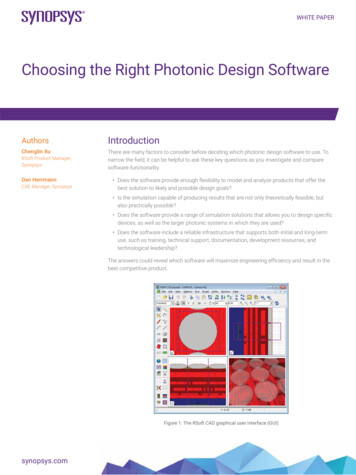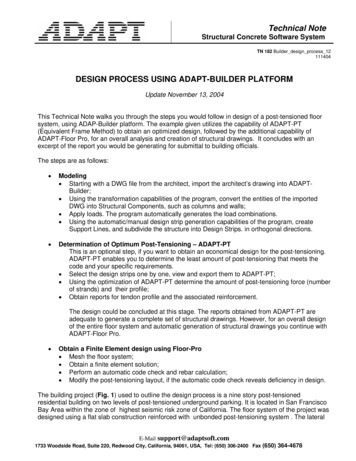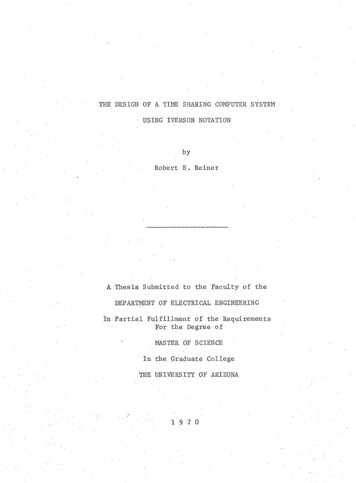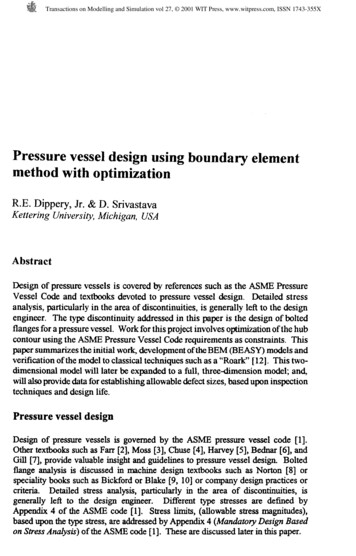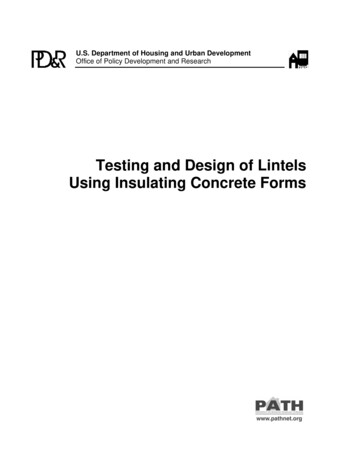
Transcription
Photonic Inverse Design usingthe Adjoint MethodAdam Reid - Co-founder and VP EngineeringLumerical Inc.March 2, 2019
Photonic Inverse Design Using the Adjoint MethodSee more@Booth 5438 Lumopt1 Python module for adjoint sensitivity analysis FDTD Solutions for 2D/3D simulation SciPy gradient based optimization algorithmsTarget 0.5 Highly efficient optimization of photonic componentsTry yourself: Examples and softwarelumeri.ca/ofc Lumerical y/lumerical
Motivation Component design challenging, even forbasic components We would like a lot: No reflections No loss Insensitive to manufacturingimperfections Works for range of wavelengths Works at different temperaturesy(x) ? Usually no analytic solution Good solutions using PSO Zhang, Y., Yang, S., Eu-Jin Lim, A., Lo, G-Q., Galland, C., Baehr-Jones, T., andHochberg, M., “A compact and low loss Y-junction for submicron siliconwaveguide,” Optics Express 21, 1310-1316 (2013). Can we do better with adjoint methods? Lumerical Inc.https://github.com/lukasc-ubc/SiEPIC EBeam PDK
Lumerical’s Suite of Simulation Tools for PhotonicsThis demo uses FDTD simulation automated via Python API Lumerical Inc.
Lumopt: Python Based Inverse Design for Lumerical FDTD Lumopt: open source adjointsensitivity analysishttps://github.com/chriskeraly/lumopt Collaboration with Lumericalover past year Targets integrated photonics Now included with FDTDSolutionsOptics Express, Vol 21, Issue 18, uri oe-21-18-21693 Lumerical Inc.PROPRIETARY AND CONFIDENTIAL
Inverse Design vs Forward Design3dB Power SplitterFDTD SolutionsNANOPHOTONIC MAXWELL’SSOLVERTraditional DesignCostlyIterationsLumoptInverse DesignFOMIL 0.1dBFDTD SolutionsNANOPHOTONIC MAXWELL’SSOLVERAdjoint optimization tool Lumerical Inc.PROPRIETARY AND CONFIDENTIALFOMIL 0.3dB
Parametric Shape based adjoint optimizationParametric shape Defines design space Optimization parameters𝑥𝑥𝑖𝑖 , 𝑦𝑦 𝑝𝑝𝑖𝑖𝑠𝑠 𝒑𝒑Adjoint sensitivity analysis Efficiently compute gradient 2 FDTD simulations Independent of # parametersGradient based optimization Highly efficient optimization Uses more physics of deviceForward 𝑝𝑝 a Lumerical Inc.
Example: Full component design flow for Y-BranchLumopt in Action
Full component design flow for Y-Branch Objective: build a splitter like prior art below Use inverse design to build splitter section (1) Add waveguide offset arms (2) post-optimization2.1. 15μmhttps://github.com/lukasc-ubc/SiEPIC EBeam PDKA compact and low loss Y-junction for submicron silicon waveguideYi Zhang, et al, Optics Express Vol. 21, Issue 1, pp. 1310-1316 (2013) Lumerical Inc.
An Inverse Design Flow Lumerical Inc.
Step 1: Define base simulation2D simulation Uses an effective index for waveguide Good approximation Fast simulationInput waveguide Figure of meritmeasurement TE ModeTE Source modeFDTD simulation regionBase simulation is defined by Lumerical Script (lsf) Lumerical Inc.Outputwaveguides
Step 2: Define parametric shape Parametric shape defined as Python function Function argument is list of parameters Function returns list of polygon vertices Lumerical Inc.
Step 3: Run fast 2D optimizationThis optimization runs in 20-30 minutesFOM 1 ideal Lumerical Inc.
Step 4: Refine with 3D optimization This step is largely the same as 2D simulation Takes a bit longer to run Should complete with few iterations if seeded with 2D solution Lumerical Inc.
Step 5: Save design to GDSII Optimized shape and output arms saved to GDSII Similar to prior art, but has a few ripples!Example design Lumerical Inc.Prior art
Step 5: Y splitter example: Compact model extraction from layout Import the final GDSII mask into 3Dsimulation Define ports Extract the S-parameters Save to data file for INTERCONNECTcircuit simulation Lumerical Inc.
Example: Broadband & Compact Y-BranchLumopt in Action
Broadband & Compact Splitter Can we make a smaller splitter? Can we ensure broadband? Parametric shape with output waveguides,20 parameters 5x5 footprint footprint FOM taken over C L bands0.5μm 15μmhttps://github.com/lukasc-ubc/SiEPIC EBeam PDKA compact and low loss Y-junction for submicron silicon waveguideYi Zhang, et al, Optics Express Vol. 21, Issue 1, pp. 1310-1316 (2013) Lumerical Inc.5μm5μm
Broadband Inverse Design Optimize FOM over a spectrum No additional FDTD simulations required!Single wavelength Lumerical Inc.Broadband
Step 3: Run fast 2D optimizationThis example takes 60 minutes to run:FOM 0.5 ideal Lumerical Inc.
Example: Grating couplerAvailable soon!!
Double etch grating coupler 80 optimization parametersExample available soonNominal deviceFOM 2 ideal Lumerical Inc.
Example: Robust Y-BranchLumopt in Action
Co-OptimizationCo-optimization:Example uses: Run multiple optimizations concurrently Dual polarization devices (different FOM) Figure of merit or structure can bedifferent Optimize process corners (different geometry) Optimizations share same parameters Multiple wavelengths (different FOM)Dual polarization co-optimizationFOM(𝒑𝒑) 𝒑𝒑 𝑝𝑝1 , , 𝑝𝑝𝑁𝑁 Lumerical Inc.PROPRIETARY AND CONFIDENTIALFOM1(𝒑𝒑)TETE FOM2(𝒑𝒑)TMTM
Co-optimization: Robust splitter Build a splitter tolerant to manufacturing error Co-optimize 2 different shapes (same parameters) “Over etch” slightly smaller than nominal “Under etch” slightly larger than nominal Same FOM functionOver etchUnder etchTETE Lumerical Inc.TETE
Co-optimization: Robust splitter Setup 2 optimizations Sum the figures of meritCo-optimization of /- 20nm on edge position 2 FDTD simulations/FOM/iterationNominal deviceFOM 2 ideal Lumerical Inc.Nice smooth shape!
Upcoming features
Layout using Cadence’s Virtuoso CurvyCore Technology Non-Manhattan shapes Symbolic equations provide accuratemathematical model Generates high-quality polygonrepresentations for fabrication Ideal for inverse design shapes Lumerical Inc.
Two Approaches to Inverse DesignParametric Geometry OptimizationTopology Optimization Parametric shape defines/limits designspace No intuition about shape required! Finds optimal parameters for shape(s) User provides footprint and 2 materials Solver finds best solution𝝐𝝐𝒍𝒍𝒍𝒍𝒍𝒍 𝟏𝟏. ��𝒉 𝟐𝟐. 𝟖𝟖𝟖𝟖 Lumerical Inc.PROPRIETARY AND CONFIDENTIAL
Topology OptimizationSupports: Broadband Quasi-2D Constrained feature size Co-optimization Lumerical Inc.PROPRIETARY AND CONFIDENTIAL
Topology Optimization: Broadband (1450-1650nm) TE Splitter Lumerical Inc.PROPRIETARY AND CONFIDENTIAL
Next StepsTry running examples Stick to 2D, get results in minutesMore examples available in applications gallery Set max iter 3 to get suboptimal device fastTry some modifications Change device footprint Change bandwidth Change number of optimization parameters Try pCell suggestions in tutorial Lumerical Inc.See moreExhibit Hall Booth 5438
Lumerical Inc. March 2, 2019 Photonic Inverse Design using the Adjoint Method. Adam Reid - Co-founder and VP Engineering
